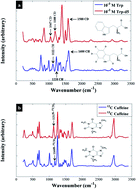当前位置:
X-MOL 学术
›
Anal. Methods
›
论文详情
Our official English website, www.x-mol.net, welcomes your
feedback! (Note: you will need to create a separate account there.)
Towards improved quantitative analysis using surface-enhanced Raman scattering incorporating internal isotope labelling
Analytical Methods ( IF 2.7 ) Pub Date : 2017-11-15 00:00:00 , DOI: 10.1039/c7ay02527k Abdu Subaihi 1, 2, 3, 4, 5 , Yun Xu 1, 2, 3, 4, 5 , Howbeer Muhamadali 1, 2, 3, 4, 5 , Shaun T. Mutter 1, 2, 3, 4, 5 , Ewan W. Blanch 6, 7, 8, 9 , David I. Ellis 1, 2, 3, 4, 5 , Royston Goodacre 1, 2, 3, 4, 5
Analytical Methods ( IF 2.7 ) Pub Date : 2017-11-15 00:00:00 , DOI: 10.1039/c7ay02527k Abdu Subaihi 1, 2, 3, 4, 5 , Yun Xu 1, 2, 3, 4, 5 , Howbeer Muhamadali 1, 2, 3, 4, 5 , Shaun T. Mutter 1, 2, 3, 4, 5 , Ewan W. Blanch 6, 7, 8, 9 , David I. Ellis 1, 2, 3, 4, 5 , Royston Goodacre 1, 2, 3, 4, 5
Affiliation

|
Raman spectroscopy has attracted considerable interest during the past two decades as a vibrational technique used for the molecular characterisation of different molecules. Whilst the Raman effect is known to be generally weak, it is also known that this can be greatly improved using surface-enhanced Raman scattering (SERS). Indeed, in recent years, the power of SERS for rapid identification and quantification of target analytes in a wide range of applications has been repeatedly demonstrated in multiple studies. Moreover, the application of SERS in combination with an isotopically labelled compound (ILC), as an internal standard, has also very recently shown promising results for quantitative SERS measurements, by improving both its accuracy and precision. This is due to the 12C and 13C or 1H and 2H (D) having similar physicochemical properties. The use of these internal standards results in the reduction of any influences due to the number of nanoparticles within the analysis zone and fluctuations in laser fluence. Thus, in this study we have employed SERS for quantitative detection of tryptophan (Trp) and caffeine. These have been chosen because Trp is readily available as the deuterated form and caffeine is available in both 12C and 13C. Quantum chemical calculations based on density functional theory (DFT) have been utilized to determine the vibrational characteristics of the target analytes. For SERS analysis incorporating isotopologues of tryptophan three independent experiments were conducted with three different batches of nanoparticles over a 12 month period; our results show that the use of this internal standard improves quantification of this target molecule. In particular for the independent test sets (i.e., samples not used in quantitative partial least squares regression (PLSR) model construction) we observed improvements in the linearity for test set predictions, as well as lower errors in test set predictions, when isotope internal standards were used during SERS for both deuterated tryptophan as well as 13C caffeine. This work is an extension of and a natural progression from our earlier studies. By exploring additional analytes of interest, allowing for the assessment of the different types of stable isotopes as internal standards, and demonstrating the transfer/robustness of isotopologues for use with SERS, we believe this approach could be readily extended to other biologically-relevant compounds.
中文翻译:

借助结合内部同位素标记的表面增强拉曼散射,实现改进的定量分析
在过去的二十年中,作为用于不同分子的分子表征的振动技术,拉曼光谱法引起了人们的极大兴趣。尽管已知拉曼效应通常较弱,但也可以使用表面增强拉曼散射(SERS)大大改善这一点。的确,近年来,在多项研究中反复证明了SERS在各种应用中快速鉴定和定量目标分析物的能力。此外,将SERS与作为内部标准的同位素标记化合物(ILC)结合使用,最近还显示出通过提高SERS的准确性和精密度而进行定量SERS测量的令人鼓舞的结果。这是由于12 C和13C或1 H和2 H(D)具有相似的物理化学性质。这些内标的使用可减少由于分析区内纳米颗粒的数量和激光注量的波动引起的任何影响。因此,在这项研究中,我们采用SERS定量检测色氨酸(Trp)和咖啡因。选择这些是因为Trp可以作为氘代形式获得,而咖啡因可以在12 C和13中获得C.基于密度泛函理论(DFT)的量子化学计算已用于确定目标分析物的振动特性。对于结合色氨酸同位素同质异体的SERS分析,在12个月的时间内对三个不同批次的纳米颗粒进行了三个独立的实验;我们的结果表明,使用此内标可改善该目标分子的定量。特别是对于独立的测试集(即,未用于定量偏最小二乘回归(PLSR)模型构建的样本),我们观察到当同位素内标物时,测试集预测的线性度有所改善,并且测试集预测的误差较低在SERS期间用于氘化色氨酸和13C咖啡因。这项工作是我们早期研究的延伸和自然发展。通过探索其他感兴趣的分析物,允许评估不同类型的稳定同位素作为内标,并证明了与SERS一起使用的同位素同位素的转移/稳健性,我们相信这种方法可以很容易地扩展到其他与生物相关的化合物。
更新日期:2017-11-22
中文翻译:

借助结合内部同位素标记的表面增强拉曼散射,实现改进的定量分析
在过去的二十年中,作为用于不同分子的分子表征的振动技术,拉曼光谱法引起了人们的极大兴趣。尽管已知拉曼效应通常较弱,但也可以使用表面增强拉曼散射(SERS)大大改善这一点。的确,近年来,在多项研究中反复证明了SERS在各种应用中快速鉴定和定量目标分析物的能力。此外,将SERS与作为内部标准的同位素标记化合物(ILC)结合使用,最近还显示出通过提高SERS的准确性和精密度而进行定量SERS测量的令人鼓舞的结果。这是由于12 C和13C或1 H和2 H(D)具有相似的物理化学性质。这些内标的使用可减少由于分析区内纳米颗粒的数量和激光注量的波动引起的任何影响。因此,在这项研究中,我们采用SERS定量检测色氨酸(Trp)和咖啡因。选择这些是因为Trp可以作为氘代形式获得,而咖啡因可以在12 C和13中获得C.基于密度泛函理论(DFT)的量子化学计算已用于确定目标分析物的振动特性。对于结合色氨酸同位素同质异体的SERS分析,在12个月的时间内对三个不同批次的纳米颗粒进行了三个独立的实验;我们的结果表明,使用此内标可改善该目标分子的定量。特别是对于独立的测试集(即,未用于定量偏最小二乘回归(PLSR)模型构建的样本),我们观察到当同位素内标物时,测试集预测的线性度有所改善,并且测试集预测的误差较低在SERS期间用于氘化色氨酸和13C咖啡因。这项工作是我们早期研究的延伸和自然发展。通过探索其他感兴趣的分析物,允许评估不同类型的稳定同位素作为内标,并证明了与SERS一起使用的同位素同位素的转移/稳健性,我们相信这种方法可以很容易地扩展到其他与生物相关的化合物。










































 京公网安备 11010802027423号
京公网安备 11010802027423号